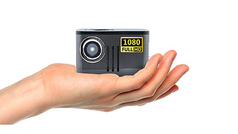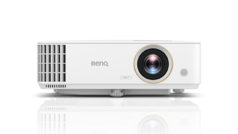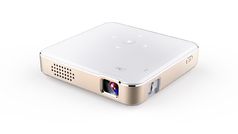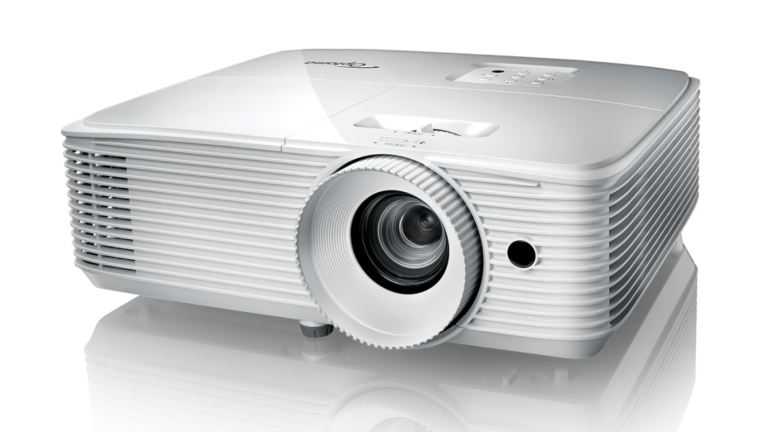
[ad_1]
Designed both for gaming and for watching movies and TV, the $799 Optoma HD39HDR is one of a growing number of 1080p home projectors that can accept a 4K UHD (3,840-by-2,160-pixel) HDR signal and down-convert the resolution to 1080p. Some projectors in this category accept the input without really offering any of the benefits that high dynamic range promises for a wider color gamut or range of brightness levels. Others, including the Optoma, make good use of HDR. In my tests, the HD39HDR delivered more-vibrant color and far better shadow detail when I played the 4K HDR versions of movies on my Blu-ray player than when playing the 1080p SDR versions of the same titles.
Games and Movies…With the Lights On
Optoma includes the HD39HDR on its lists of both gaming projectors and home entertainment projectors for watching movies and TV in ambient light. For games, it offers low lag to speed up your reaction time; Optoma rates it for up to 8.4 milliseconds (ms) at 1080p/120Hz, and I measured it by a Leo Bodnar meter(Opens in a new window) at 16.4ms at 1080p/60Hz. For both games and home entertainment with the lights on, it delivers a bright picture, reflected in its rating of 4,000 ANSI lumens.

Another feature of particular interest to gamers is the projector’s compact size, which makes it easy to bring to a friend’s house, or to store when not in use. The sound system, with an onboard 10-watt speaker, can also come in handy, thanks to robust-enough volume to fill a small family room. That said, the sound quality is marginal enough that you’ll likely want to plug an external sound system into the 3.5mm audio-out jack. Note, too, that Optoma doesn’t include a carrying case for the projector.
The HD39HDR’s high brightness is thanks in part to its six-segment RYGCWB (Red, Yellow, Green, Cyan, White, Blue) color wheel, paired with the single 1,920-by-1,080 DLP chip. The yellow panel helps it produce a brighter, more vibrant yellow than many DLP projectors offer, while the white panel lets it deliver a brighter image than it could without one. As with any projector with a white panel—including, for example, the BenQ TH585—this also affects color accuracy. DLP projectors without white panels in their color wheels, like the BenQ HT2150ST, tend to offer better color accuracy, but they also tend to have lower brightness, and are better choices for traditional home theater in a dark room.
Similar Products
Setup and Image Quality
Setting up the HD39HDR is standard fare. At 7.7 pounds and 4.5 by 12.4 by 9.5 inches (HWD), the body is easy to handle. The 1.3x zoom offers flexibility for positioning, and the +/- 40 degree vertical keystone lets you square off the image if you need to tilt the projector to point at the screen.
Image inputs include two HDMI ports—one for up to 4K UHD HDR, and one for up to 1080p. After setting up the projector for a 90-inch diagonal image, I measured it at 9 feet and 4 inches from the screen.

Contrast, black level, and the sense of three-dimensionality for dark scenes is good enough for both SDR and HDR for most people to find acceptable for viewing in a dark room. Videophiles would count it lacking on all three scores, but that’s a minor issue at most for a projector meant primarily for use in ambient light. High brightness is more important when lights are on, because it helps counter the ambient light’s tendency to brighten up black levels and eliminate the benefit of truly high contrast.
A Look at the Color
Some colors in both SDR and HDR input were a little off in my tests. With SDR input, blues, greens, and yellows were a little darker than they should be. With HDR input, colors were brighter, but what should have been a bright yellow dress in one scene bordered on bright orange instead. However, the projector handled flesh tones well with both SDR and HDR, while memory colors like blue skies and oceans and green leaves were well within a realistic range.
That said, if you want to improve the color accuracy, or otherwise tune the image, the menus offer all the settings you need. And if you’re willing to pay for professional calibration, the projector supports ISF Day, ISF Night, and ISF 3D modes.

Short of calibration, the preferred mode for SDR input will depend largely on the level of ambient light and the screen size you choose. The sRGB mode offered the best color accuracy with default settings in my tests, but Cinema was a close second and a little brighter, while the brighter-still HDR Sim delivered the best contrast for dark scenes. Game mode offered even better contrast, and it also brightened up dark areas, making details in those areas easier to see. That’s useful for games, since it lets you see details quickly, but it tends to make dark scenes in movies brighter than they should be.

As is typical, the brightest mode (called Bright) had a noticeably green tint. However, the bias was less than with some projectors. Most buyers should consider it usable on an occasional basis if they need the extra brightness.
For HDR input, the HD39HDR automatically switches to, and only allows, its one HDR picture mode, which is well worth using. In my tests, the HDR versions of movies on disc delivered more-vibrant color and showed more shadow detail than the same movies in 1080p SDR format.
Assessing the Brightness
Using Society of Motion Picture and Television Engineers (SMPTE)(Opens in a new window) recommendations, 4,000 lumens is bright enough for a 160-inch, 1.0-gain screen in moderately bright ambient light. However, the four modes with best picture quality—Cinema, sRGB, HDR Sim, and Game—are nowhere near as bright.
For my formal tests in a dark room, I chose Cinema mode to fill a 90-inch white screen. For informal tests in a family room with lots of windows, even the sRGB mode was bright enough to light up an 80-inch, 1.0 gain screen both with lights on at night and late in the day with the sun low in the sky. HDR Sim mode provided a more watchable picture with bright sunlight outside.
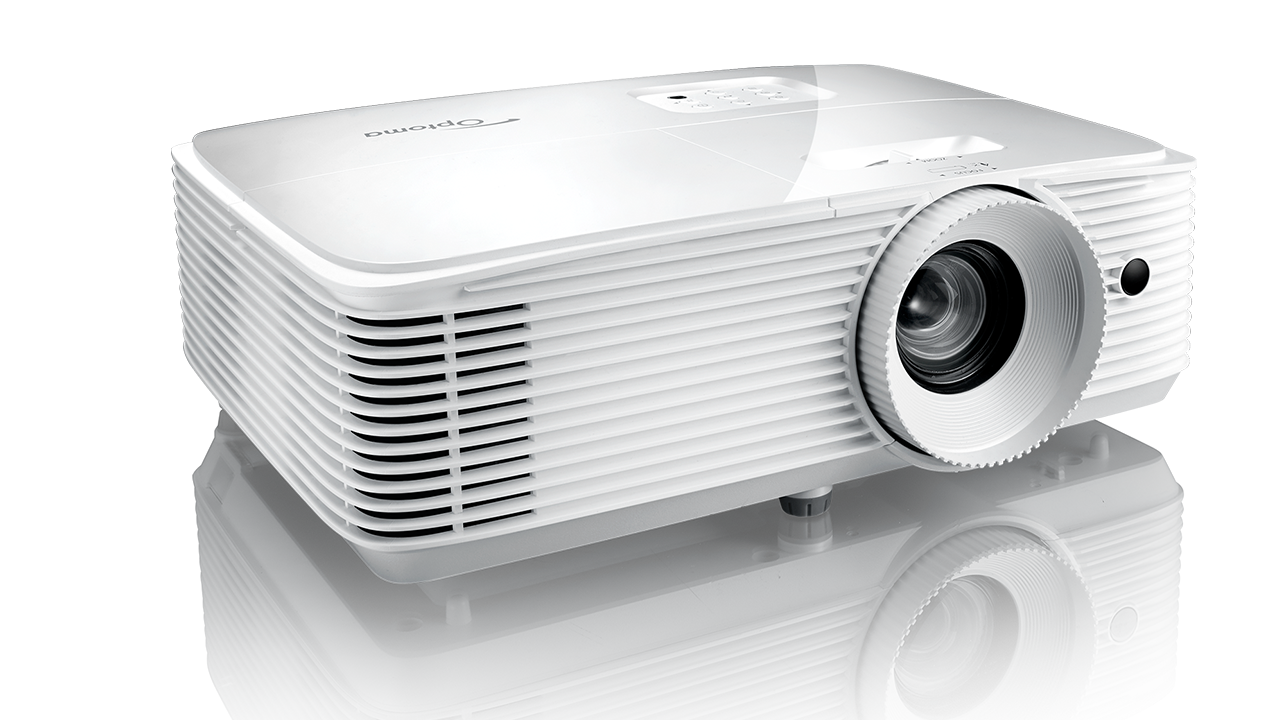
As for the 3D functionality, like most of its competition, the HD39HDR works with DLP-link glasses and offers only one 3D picture mode (unless you count the ISF mode that needs calibration before it becomes available). It also provides an unusually bright image for 3D, compared to its 2D modes. I saw no crosstalk in my tests and only minor 3D-related motion artifacts by today’s standards.
Like any single-chip projector, the HD39HDR can be prone to exhibiting rainbow artifacts—red-green-blue flashes—but I saw these only rarely, and they weren’t as obvious as with many DLP projectors. Even so, if you tend to see these artifacts readily (or don’t know whether you do), be sure to buy the projector from a source that allows returns without a restocking fee, in case you find them bothersome.
Lights, Projector, Action!
The Optoma HD39HDR is designed for rooms with ambient light—lots of it. You can use it in a dark room, as well, but if that’s your primary interest for a projector, you’re better off considering one that’s designed for dark-room viewing, like the BenQ HT2150ST. For lights-on viewing, you also might want to take a look at the BenQ TH585, which costs less than the HD39HDR but isn’t as bright.

For any given level of ambient light, the HD39HDR is enough of a light cannon, versus the TH585, to give you an equally bright, satisfyingly high-quality picture at a larger size. So when you turn the HD39HDR on, you’ll rarely need to turn any lights off.
3.5

(Opens in a new window)
(Opens in a new window)
View More
Optoma’s HD39HDR offers low input lag for fast reaction time in games, plus sufficient brightness for a large movie or game image to stand up easily to ambient light in a family room.
[ad_2]
Source link : https://www.pcmag.com/reviews/optoma-hd39hdr
